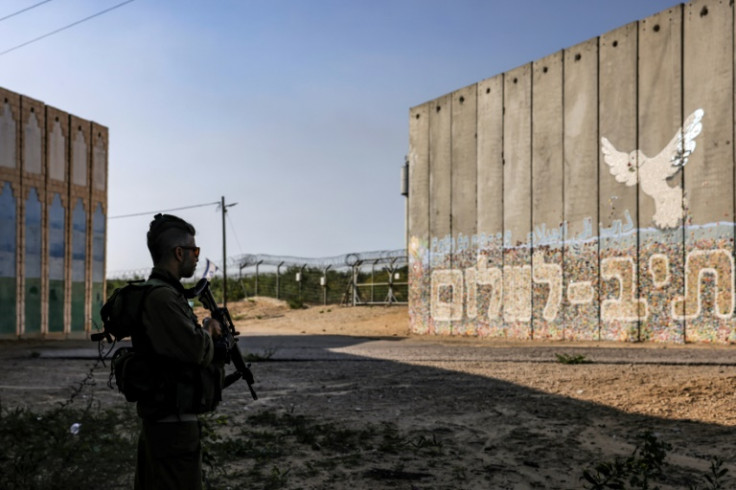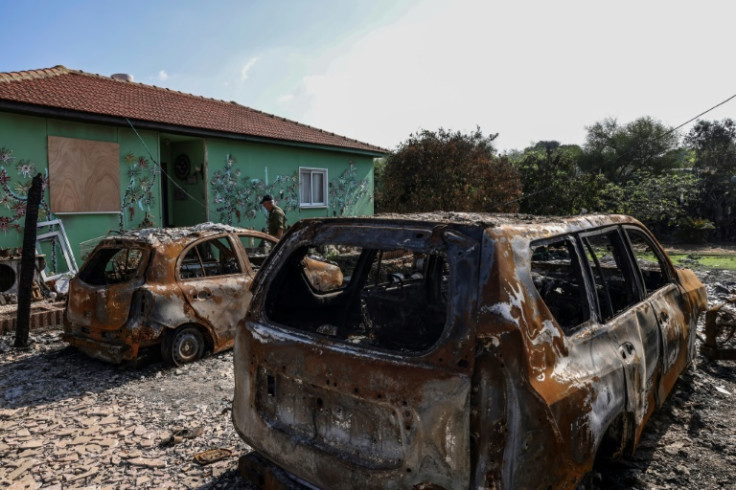The Mystery Of Israel's Last Missing October 7 Victim

As air raid sirens rang out on the morning of October 7, Bilha Inon and her husband Yakovi sheltered in the safe room of their home in Netiv Haasara in southern Israel.
An hour into the Hamas attack their son spoke to them on the phone. It was the last sign of life from Bilha, the only Israeli victim still officially unaccounted for.
While her family is convinced she died alongside her husband in the Hamas attack, Israeli officials -- who initially said she had been killed -- now say they cannot be sure.
The case underscores the difficulties the authorities have faced in locating and identifying victims of the Hamas attack, which took place over a large swath of southern Israel.
Bilha, 75, was an art teacher and ran a studio out of the green bungalow behind the couple's intricately decorated home 500 metres (yards) from the Gaza border fence.
Even the shelter where she took cover on October 7 was painted with mandalas and had a wall inscribed with "words that give strength and encouragement".
She told an Israeli newspaper five months before the attack that, while most families would leave during earlier rounds of fighting between Israel and Gaza militants, "many times we stay".
On the morning of October 7, the first three Palestinian militants were photographed sailing over the border wall in motorised paragliders into Netiv Haasara.
Gunmen then poured in from Gaza and killed 21 of the 900-strong community, according to the Institute for National Security Studies.
By then however, the Inons' wooden house had been hit by a shoulder-launched rocket and burned down, one of their granddaughters told Ynet, an Israeli news site.
Only the concrete foundation and charred shell of the safe room remain.
It was one of the opening salvos of the Hamas attack that resulted in the deaths of 1,170 Israelis and foreigners, most of them civilians, according to an AFP tally based on official Israeli figures.
Some 250 were taken hostage by Palestinian militants; 129 remain in captivity six months later, including 34 the military says are dead.
Israel's retaliation against Hamas has left at least 33,545 Palestinians dead, most of them women and children, according to the Hamas-run Gaza health ministry.
In the weeks following October 7, the Israeli military, police, health ministry and even archaeologists with the antiquities authority toiled to locate and identify the remains of over 200 missing persons.
Six months on, the official list of the missing has been whittled down to just Bilha Inon.
Mor Ynon, one of Bilha's five children, said investigators found remains that genetic testing proved belonged to her father, along with "other remains that didn't yield DNA".
An army investigation initially concluded that Bilha and Yakovi both died in their home.
But they walked that back when forensics experts said it was not possible for all DNA traces to be erased in a fire.
Her children, however, have resolved that their parents died together at home. They sat shiva, the Jewish mourning ritual, for them the day after the attack.
"As far as we're concerned, my mother is not missing," Ynon said.
Her brother Maoz Inon, a longtime peace activist, told AFP that "the one who's been missing... is the Israeli government".
"The army always told us the same thing: Hamas is deterred, you're protected," he said.
"What the army says is irrelevant. I judge every institution, every group, every person based on their actions."
Israel's health ministry, which runs the forensics lab that identified human remains from the attacks, declined comment as did the police and the military.
"It's a mystery," Lieutenant Colonel Dana Nof, the army officer coordinating with the family, told Israel's Channel 12 last month. "We're trying to clarify and reach a conclusion that will tell if she is alive or not."
"The chance that she's a hostage is one of the possibilities that's being checked," Nof said.
However, most experts on the case agree that without conclusive evidence, anything -- including that Bilha Inon was taken hostage -- is possible, the Channel 12 report said.
For Mor, however, the trauma has not faded.
"Unfortunately, the event that began on October 7 hasn't ended so long as there are over 100 hostages in the Gaza Strip," she said.


© Copyright AFP {{Year}}. All rights reserved.





















